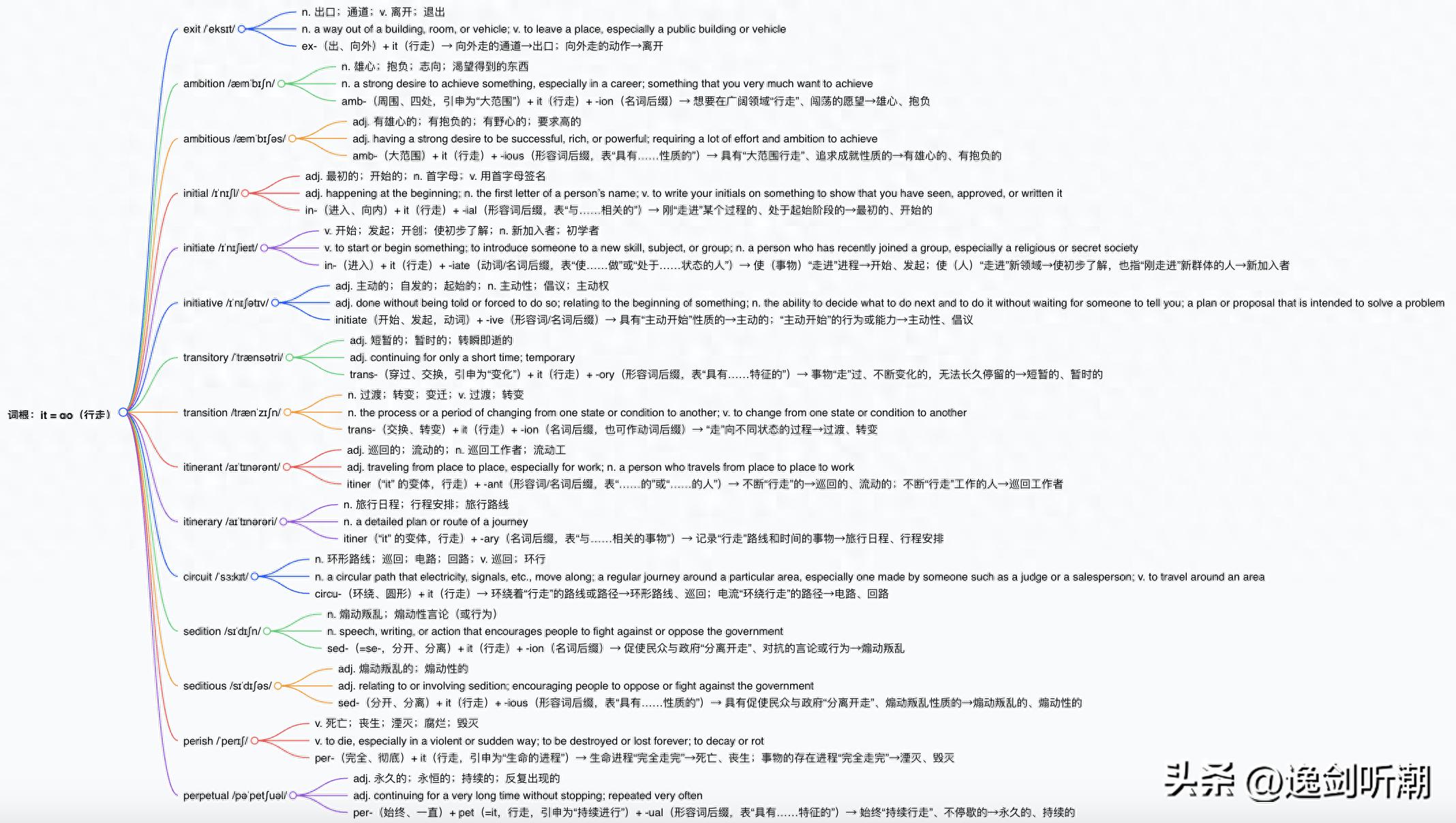it=go,表示“行走”

- exit /ˈeksɪt/
** 中文释义:n. 出口;通道;v. 离开;退出。
** 英文释义:n. a way out of a building, room, or vehicle; v. to leave a place, especially a public building or vehicle.
** 构词:ex-(出、向外)+ it(行走)→ 向外走的通道→出口;向外走的动作→离开。
** 例句:Please use the emergency exit in case of fire.(如遇火灾,请使用紧急出口。) / She exited the room without saying a word.(她一句话没说就离开了房间。) - ambition /æmˈbɪʃn/
** 中文释义:n. 雄心;抱负;志向;渴望得到的东西。
** 英文释义:n. a strong desire to achieve something, especially in a career; something that you very much want to achieve.
** 构词:amb-(周围、四处,引申为 “大范围”)+ it(行走)+ -ion(名词后缀)→ 想要在广阔领域 “行走”、闯荡的愿望→雄心、抱负。
** 例句:His ambition is to become a leading scientist in the field.(他的志向是成为该领域的顶尖科学家。) / She has no ambition for fame or fortune.(她对名利没有渴望。) - ambitious /æmˈbɪʃəs/
** 中文释义:adj. 有雄心的;有抱负的;有野心的;要求高的。
** 英文释义:adj. having a strong desire to be successful, rich, or powerful; requiring a lot of effort and ambition to achieve.
** 构词:amb-(大范围)+ it(行走)+ -ious(形容词后缀,表 “具有…… 性质的”)→ 具有 “大范围行走”、追求成就性质的→有雄心的、有抱负的。
** 例句:She’s an ambitious young professional who wants to climb the career ladder quickly.(她是一位有抱负的年轻职场人,希望快速晋升。) / It’s an ambitious project that will take at least five years to complete.(这是一个要求很高的项目,至少需要五年才能完成。) - initial /ɪˈnɪʃl/
** 中文释义:adj. 最初的;开始的;n. 首字母;v. 用首字母签名。
** 英文释义:adj. happening at the beginning; n. the first letter of a person’s name; v. to write your initials on something to show that you have seen, approved, or written it.
** 构词:in-(进入、向内)+ it(行走)+ -ial(形容词后缀,表 “与…… 相关的”)→ 刚 “走进” 某个过程的、处于起始阶段的→最初的、开始的。
** 例句:The initial stage of the project involves lots of research.(项目的初始阶段涉及大量研究。) / Please sign your initials at the bottom of each page.(请在每一页底部签上你的首字母。) - initiate /ɪˈnɪʃieɪt/
** 中文释义:v. 开始;发起;开创;使初步了解;n. 新加入者;初学者。
** 英文释义:v. to start or begin something; to introduce someone to a new skill, subject, or group; n. a person who has recently joined a group, especially a religious or secret society.
** 构词:in-(进入)+ it(行走)+ -iate(动词 / 名词后缀,表 “使…… 做” 或 “处于…… 状态的人”)→ 使(事物)“走进” 进程→开始、发起;使(人)“走进” 新领域→使初步了解,也指 “刚走进” 新群体的人→新加入者。
** 例句:The government initiated a new program to reduce poverty.(政府发起了一项减少贫困的新计划。) / She was initiated into the art of calligraphy by her grandfather.(她由祖父启蒙学习书法。) / The initiates were given a special training session.(新加入者接受了一次特别培训。) - initiative /ɪˈnɪʃətɪv/
** 中文释义:adj. 主动的;自发的;起始的;n. 主动性;倡议;主动权。
** 英文释义:adj. done without being told or forced to do so; relating to the beginning of something; n. the ability to decide what to do next and to do it without waiting for someone to tell you; a plan or proposal that is intended to solve a problem.
** 构词:initiate(开始、发起,动词)+ -ive(形容词 / 名词后缀)→ 具有 “主动开始” 性质的→主动的;“主动开始” 的行为或能力→主动性、倡议。
** 例句:She took the initiative to organize a team-building activity.(她主动组织了一次团队建设活动。) / The company’s new initiative aims to improve employee well-being.(公司的新倡议旨在改善员工福利。) - transitory /ˈtrænsətri/
** 中文释义:adj. 短暂的;暂时的;转瞬即逝的。
** 英文释义:adj. continuing for only a short time; temporary.
** 构词:trans-(穿过、交换,引申为 “变化”)+ it(行走)+ -ory(形容词后缀,表 “具有…… 特征的”)→ 事物 “走” 过、不断变化的,无法长久停留的→短暂的、暂时的。
** 例句:The pain is transitory and should disappear within a few hours.(这种疼痛是暂时的,几小时内就会消失。) / Her happiness at the news was transitory, as she soon realized the challenges ahead.(她听到消息时的喜悦很短暂,因为她很快意识到了前方的挑战。) - transition /trænˈzɪʃn/
** 中文释义:n. 过渡;转变;变迁;v. 过渡;转变。
** 英文释义:n. the process or a period of changing from one state or condition to another; v. to change from one state or condition to another.
** 构词:trans-(交换、转变)+ it(行走)+ -ion(名词后缀,也可作动词后缀)→ “走” 向不同状态的过程→过渡、转变。
** 例句:The transition from school to work can be difficult for some graduates.(从学校到职场的过渡对一些毕业生来说可能很困难。) / The company is transitioning to a more sustainable business model.(该公司正转型为更具可持续性的商业模式。) - itinerant /aɪˈtɪnərənt/
** 中文释义:adj. 巡回的;流动的;n. 巡回工作者;流动工。
** 英文释义:adj. traveling from place to place, especially for work; n. a person who travels from place to place to work.
** 构词:itiner(“it” 的变体,行走)+ -ant(形容词 / 名词后缀,表 “…… 的” 或 “…… 的人”)→ 不断 “行走” 的→巡回的、流动的;不断 “行走” 工作的人→巡回工作者。
** 例句:He worked as an itinerant musician, performing in different towns.(他曾是一名巡回音乐家,在不同城镇演出。) / The village used to have many itinerants who came to harvest crops.(这个村庄过去有很多来收割庄稼的流动工。) - itinerary /aɪˈtɪnərəri/
** 中文释义:n. 旅行日程;行程安排;旅行路线。
** 英文释义:n. a detailed plan or route of a journey.
** 构词:itiner(“it” 的变体,行走)+ -ary(名词后缀,表 “与…… 相关的事物”)→ 记录 “行走” 路线和时间的事物→旅行日程、行程安排。
** 例句:Can you send me a copy of our travel itinerary?(你能把我们的旅行行程发给我一份吗?) / Our itinerary includes visits to three historical sites tomorrow.(我们明天的行程包括参观三个历史景点。) - circuit /ˈsɜːkɪt/
** 中文释义:n. 环形路线;巡回;电路;回路;v. 巡回;环行。
** 英文释义:n. a circular path that electricity, signals, etc., move along; a regular journey around a particular area, especially one made by someone such as a judge or a salesperson; v. to travel around an area.
** 构词:circu-(环绕、圆形)+ it(行走)→ 环绕着 “行走” 的路线或路径→环形路线、巡回;电流 “环绕行走” 的路径→电路、回路。
** 例句:The racing car completed three laps of the circuit.(赛车跑完了三圈环形赛道。) / The judge goes on circuit twice a year to hear cases in small towns.(法官每年巡回两次,到小镇审理案件。) / A broken wire caused a short circuit in the machine.(一根断电线导致机器短路。) - sedition /sɪˈdɪʃn/
** 中文释义:n. 煽动叛乱;煽动性言论(或行为)。
** 英文释义:n. speech, writing, or action that encourages people to fight against or oppose the government.
** 构词:sed-(=se-,分开、分离)+ it(行走)+ -ion(名词后缀)→ 促使民众与政府 “分离开走”、对抗的言论或行为→煽动叛乱。
** 例句:The government accused him of sedition and arrested him.(政府指控他煽动叛乱并将其逮捕。) / His speeches were filled with sedition against the ruling party.(他的演讲中满是反对执政党的煽动性言论。) - seditious /sɪˈdɪʃəs/
** 中文释义:adj. 煽动叛乱的;煽动性的。
** 英文释义:adj. relating to or involving sedition; encouraging people to oppose or fight against the government.
** 构词:sed-(分开、分离)+ it(行走)+ -ious(形容词后缀,表 “具有…… 性质的”)→ 具有促使民众与政府 “分离开走”、煽动叛乱性质的→煽动叛乱的、煽动性的。
** 例句:The newspaper was banned for publishing seditious articles.(该报纸因刊登煽动性文章被取缔。) / He was charged with making seditious remarks at a public rally.(他被控在公开集会上发表煽动性言论。) - perish /ˈperɪʃ/
** 中文释义:v. 死亡;丧生;湮灭;腐烂;毁灭。
** 英文释义:v. to die, especially in a violent or sudden way; to be destroyed or lost forever; to decay or rot.
** 构词:per-(完全、彻底)+ it(行走,引申为 “生命的进程”)→ 生命进程 “完全走完”→死亡、丧生;事物的存在进程 “完全走完”→湮灭、毁灭。
** 例句:Thousands of people perished in the earthquake.(数千人在地震中丧生。) / The ancient civilization perished long ago.(这个古老文明早已湮灭。) / Food will perish quickly if not stored properly.(食物如果储存不当会很快腐烂。) - perpetual /pəˈpetʃuəl/
** 中文释义:adj. 永久的;永恒的;持续的;反复出现的。
** 英文释义:adj. continuing for a very long time without stopping; repeated very often.
** 构词:per-(始终、一直)+ pet(=it,行走,引申为 “持续进行”)+ -ual(形容词后缀,表 “具有…… 特征的”)→ 始终 “持续行走”、不停歇的→永久的、持续的。
** 例句:She’s tired of the perpetual noise from the construction site next door.(她受够了隔壁建筑工地持续不断的噪音。) / The company offers its employees a perpetual contract after five years of service.(该公司为服务满五年的员工提供永久合同。)
备注说明
- 词根 “it” 的变体:
部分单词中 “it” 会以 “itiner”、“pet” 等形式出现(如 “itinerant”、“perpetual”),本质仍保留 “行走” 的核心含义,需注意识别这种变体形式,避免因拼写差异忽略词根关联。 - 多词性现象:
部分单词(如 “exit”、“initiate”、“transition”)同时具备名词和动词词性,且不同词性下的含义都是紧密围绕 “行走” 的核心引申(如 “exit” 作名词是 “行走的出口”,作动词是 “向外行走的动作”)的,记忆时可结合词性关联理解。 - 语义褒贬差异:
以 “ambition” 为核心的衍生词(“ambition”、“ambitious”)可表中性的 “雄心、抱负”含义,也可表贬义的 “野心”的意思,需要根据语境进行判断(如描述积极目标时为褒义,描述贪婪欲望时为贬义);
而 “sedition”、“seditious” 则始终为贬义,特指 “危害政权的煽动行为”,使用时需注意语境严肃性。
记忆方法
- 词根串联法:
以 “it = 行走” 为核心含义,将单词按 “行走方向”、“行走状态”、“行走引申义” 分类记忆:
行走方向:“ex-(出)+it→exit(出口,向外走)”、“in-(进)+it→initial(初始,走进过程)”;
行走状态:“trans-(交换)+it→transition(过渡,交换着走)”、“circu-(环绕)+it→circuit(环行,环绕着走)”;
行走引申义:“amb-(大范围)+it→ambition(雄心,大范围闯荡)”、“sed-(分离)+it→sedition(叛乱,分离着走)”。 - 场景联想记忆法:
结合生活场景理解单词,如 “itinerary(行程)” 可联想 “旅行时记录每天‘行走’路线的表格”;
“hydrant(水龙头)”(虽非本次词根,但可类比)联想 “水‘行走’的出口”,同理 “exit” 联想 “人‘行走’的出口”,通过同类场景强化记忆。 - 词缀辅助记忆法:
牢记 “it” 搭配的常见词缀含义(如 “ex - 出”、“in - 进”、“trans - 交换”、“-ion 名词后缀”、“-ious 形容词后缀”),遇到陌生单词时,可通过 “词根 + 词缀” 拆解推测含义(如看到 “itinerary”,拆解 “itiner(行走)+-ary(事物)”,可推测为 “与行走相关的事物”,进而联想到 “行程”)。
注意点
- 发音区分:
部分单词拼写相近但发音不同,需注意音标细节,如 “initial /ɪˈnɪʃl/” 与 “initiate /ɪˈnɪʃieɪt/”,前者重音在首音节,后者重音也在首音节但结尾多了 “-ate” 的 /eɪ/ 音,避免口语中混淆。 - 拼写易错点:
“itinerant”、“itinerary” 中的 “itiner” 易误写为 “itiner” 之外的形式(如 “itener”),需牢记 “it” 变体为 “itiner”;
“sedition”、“seditious” 中的 “sed-” 易误写为 “se-”(虽 “sed-=se-”,但拼写固定为 “sed-”),需注意固定拼写。 - 使用语境限制:
“sedition”、“seditious” 属于正式且带有法律 / 政治色彩的词汇,日常交流中极少使用,主要用于新闻报道、法律文书等正式场景;
“perish” 多用于书面语或描述严重后果(如自然灾害中的死亡、文明的毁灭),日常描述 “死亡” 更常用 “die”,需根据语境选择合适词汇,避免用词过重或不当。
